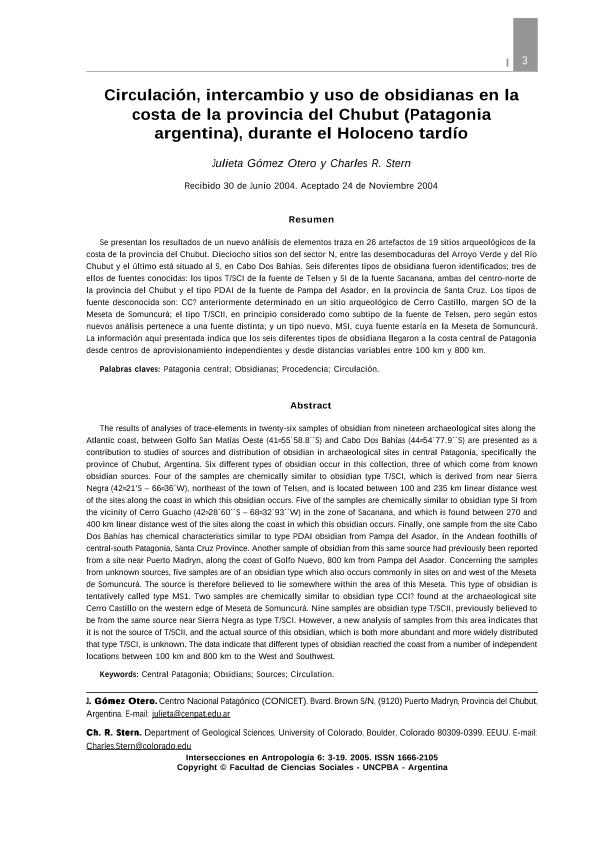Mostrar el registro sencillo del ítem
dc.contributor.author
Gomez Otero, Julieta

dc.contributor.author
Stern, Charles

dc.date.available
2020-05-20T19:38:21Z
dc.date.issued
2005-12
dc.identifier.citation
Gomez Otero, Julieta; Stern, Charles; Circulación, intercambio y uso de obsidianas en la costa de la provincia del Chubut (Patagonia argentina), durante el Holoceno tardío; Universidad Nacional del Centro de la Provincia de Buenos Aires; Intersecciones en Antropología; 6; 12-2005; 93-108
dc.identifier.issn
1666-2105
dc.identifier.uri
http://hdl.handle.net/11336/105613
dc.description.abstract
Se presentan los resultados de un nuevo análisis de elementos traza en veintiséis artefactos de diecinueve sitios arqueológicos de la costa de la provincia del Chubut. Dieciocho sitios son del sector norte, entre las desembocaduras del Arroyo Verde y del Río Chubut, y el último está situado al sur, en Cabo Dos Bahías. Seis diferentes tipos de obsidiana fueron identificados; tres de ellos de fuentes conocidas: los tipos T/SCI de la fuente de Telsen y SI de la fuente Sacanana, ambas del centro-norte de la provincia del Chubut (Stern et al. 2000), y el tipo PDAI de la fuente de Pampa del Asador, en la provincia de Santa Cruz (Stern 1999). Los tipos de fuente desconocida son: CC? anteriormente determinado en un sitio arqueológico de Cerro Castillo, margen sudoeste de la Meseta de Somuncurá; el tipo T/SCII, en principio considerado como subtipo de la fuente de Telsen, pero según estos nuevos análisis, pertenece a una fuente distinta; y un tipo nuevo, MSI, cuya fuente estaría en la Meseta de Somuncurá. La información aquí presentada indica que los seis diferentes tipos de obsidiana llegaron a la costa central de Patagonia desde centros de aprovisionamiento independientes y desde distancias variables entre 100 km y 800 km.
dc.description.abstract
The results of analyses of trace-elements in twenty-six samples of obsidian from nineteen archaeological sites along the Atlantic coast, between Golfo San Matías Oeste (41°55´58.8´´S) and Cabo Dos Bahías (44°54´77.9´´S) are presented as a contribution to studies of sources and distribution of obsidian in archaeological sites in central Patagonia, specifically the province of Chubut, Argentina. Six different types of obsidian occur in this collection, three of which come from known obsidian sources. Four of the samples are chemically similar to obsidian type T/SCI, which is derived from near Sierra Negra (42°21’S – 66°36´W), northeast of the town of Telsen, and is located between 100 and 235 km linear distance west of the sites along the coast in which this obsidian occurs. Five of the samples are chemically similar to obsidian type SI from the vicinity of Cerro Guacho (42°28´60´´S – 68°32´93´´W) in the zone of Sacanana, and which is found between 270 and 400 km linear distance west of the sites along the coast in which this obsidian occurs. Finally, one sample from the site Cabo Dos Bahías has chemical characteristics similar to type PDAI obsidian from Pampa del Asador, in the Andean foothills of central-south Patagonia, Santa Cruz Province. Another sample of obsidian from this same source had previously been reported from a site near Puerto Madryn, along the coast of Golfo Nuevo, 800 km from Pampa del Asador. Concerning the samples from unknown sources, five samples are of an obsidian type which also occurs commonly in sites on and west of the Meseta de Somuncurá. The source is therefore believed to lie somewhere within the area of this Meseta. This type of obsidian is tentatively called type MS1. Two samples are chemically similar to obsidian type CCI? found at the archaeological site Cerro Castillo on the western edge of Meseta de Somuncurá. Nine samples are obsidian type T/SCII, previously believed to be from the same source near Sierra Negra as type T/SCI. However, a new analysis of samples from this area indicates that it is not the source of T/SCII, and the actual source of this obsidian, which is both more abundant and more widely distributed that type T/SCI, is unknown. The data indicate that different types of obsidian reached the coast from a number of independent locations between 100 km and 800 km to the West and Southwest
dc.format
application/pdf
dc.language.iso
spa
dc.publisher
Universidad Nacional del Centro de la Provincia de Buenos Aires
dc.rights
info:eu-repo/semantics/openAccess
dc.rights.uri
https://creativecommons.org/licenses/by-nc-sa/2.5/ar/
dc.subject
CIRCULACIÓN
dc.subject
USO
dc.subject
OBSIDIANAS
dc.subject
COSTA PATAGONIA
dc.subject.classification
Antropología, Etnología

dc.subject.classification
Sociología

dc.subject.classification
CIENCIAS SOCIALES

dc.title
Circulación, intercambio y uso de obsidianas en la costa de la provincia del Chubut (Patagonia argentina), durante el Holoceno tardío
dc.type
info:eu-repo/semantics/article
dc.type
info:ar-repo/semantics/artículo
dc.type
info:eu-repo/semantics/publishedVersion
dc.date.updated
2020-05-05T14:11:42Z
dc.identifier.eissn
1850-373X
dc.journal.volume
6
dc.journal.pagination
93-108
dc.journal.pais
Argentina

dc.journal.ciudad
Olavarría
dc.description.fil
Fil: Gomez Otero, Julieta. Consejo Nacional de Investigaciones Científicas y Técnicas. Centro Científico Tecnológico Conicet - Centro Nacional Patagónico; Argentina
dc.description.fil
Fil: Stern, Charles. State University of Colorado at Boulder; Estados Unidos
dc.journal.title
Intersecciones en Antropología
dc.relation.alternativeid
info:eu-repo/semantics/altIdentifier/url/https://www.redalyc.org/articulo.oa?id=179514530008
Archivos asociados
